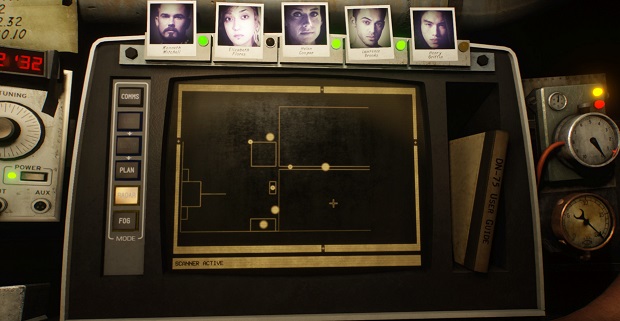Impressions: Fear Equation
Train Simulator meets The Mist
Fear Equation [official site] is a game set aboard a train and that train is one of the last safe havens in a world consumed by a terrifying mist. You play as the engineer and as you ride the rails, you'll attempt to pick up survivors, scavenge supplies and survive the dark. The mist manifests the fears of your passengers, so you'll have to monitor their nightmares in order to figure out what each night may bring. Oh, and those survivors will form factions based around their beliefs about the mist's origins and purpose. Sounds great, right? There's a catch.
On paper, Fear Equation is one of the most intriguing games I've ever encountered. The dream journals and manifestations of nightmares alone would be enough of a hook on their own, but combined with the route-plotting (which requires avoidance of dangerous human factions as well as onward progress to avoid the accumulation of mist), scavenging and belief systems that develop among passengers, it seems like the basis for a creepy survival simulation with a unique setting.
Sure, that setting has the whiff of Snowpiercer about it but yer actual Train Simulators aside, there aren't many games set entirely in the carriages and engine rooms of our rail-bound chums. Silmarils' Transarctica, now twenty two years old, is the most obvious precursor to Fear Equation that I can think of. Apart from developer Screwfly's own games, that is.
The Melbourne-based studio's first title was Zafehouse Diaries, a zombie survival game that focused on human resources rather than combat and fear. Taking a strategic view of survival, it balanced scavenging, exploring and the building of barricades with management of conflicting personalities. Like Rebuild or Project Zomboid crossed with The Sims, or a turn-based management take on Dead State's human drama, Zafehouse concerned itself with the behaviour of survivors within their shelters as much as with their journeys into danger.
If there's a common thread running through that game and the studio's second release Deadnaut right into Fear Equation, it's the NPCs. Again, survivors are presented as static headshots with a series of traits attached, including the title of the job they held before everything went to hell. Screwfly use flavour text to make sense of the numbers that underpin the workings of their survival simulations and, in Fear Equation, they've expanded that flavour to the user interface.
Rather than flicking through menu screens and stats, you wander around your train carriage consulting...well, menu screens and stats. The attempt to immerse through use of first-person wandering didn't work for me - I loved Deadnaut's claustrophobic static-spitting screens and portholes, but Fear Equation feels unnecessarily cumbersome. Screwfly seem to be aware of this and it's possible to push the function keys to flick between areas of the cabin, jumping directly to the relevant machinery and information.
There's no need to rush as the game is essentially turn-based. You can change engine speed, as if you're actually driving the train, but things only move forward when you press tab to jump between phases. Everything seems to be happening in realtime, and you can hear and see the train's movement as you make your plans, but you have all the time in the world to plan and pass instructions to your crew. Calling them crew is a bit of an overexaggeration actually - they're passengers who have to fend for themselves, and perform maintenance and scavenging in order to survive rather than because it's their job. The desperate nature of it all is hammered home by the lottery that randomly picks five passengers to head into the mist and risk their lives every day.
You can manipulate the results of the lottery to ensure you pick the right people for whatever job needs to be done and its existence appears to be in service of that Screwfly flavour as much as anything else. It's handy, when the carriages start to fill up, as it can pick five NPCs from the crowd and save time and effort, but if you're at all interested in efficiency, you'll pick the 'winners' by hand.
And then you'll tell them what to do, whether that's preparing defenses, upgrading the train, searching nearby settlements for materials and survivors, or carrying out repairs. The dream journals, which I found to be the game's most fascinating feature, tell you which threats are most likely on any given night. In each game, five manifestations are selected randomly and a certain percentage of passengers will dream about each of the fears associated with those manifestations every night. Say spiders are on the list - 50% of your passengers might dream about spiders, while 25% dream about virulent pods and the remaining 25% dream about shambling zombies. If that's the case, you'll want to dedicate most of your barricading time and resources toward web-cutters with some attention paid to pod and zombie defenses.
The problem, the occasional opacity of the interface aside, is in the numbers behind all of that flavour text. Fear Equation has all of these wonderful elements - the train itself, the manifestations in the mist, the lottery, the factions and belief systems that can cause passengers to overthrow your rule or massacre one another - but every element comes down to a balancing act. You're balancing numbers, figuring out how they stack up against one another.
That's true of all games to an extent, and Fear Equation has something in common with Crusader Kings II, which takes vast swathes of numerical data and stitches them into the form of convincing characters. With Screwfly's latest, a few hours with the game have left me thinking that the pool of data is too shallow and that the characters aren't convincing enough to care about. As I wander back and forth, pulling levers and pushing buttons, I feel as if I'm doing sums rather than playing with peoples' lives. The actual route planning, across a map that pulsates with danger and promise, is almost the saving grace, but it seems to distract from the interior management rather than sitting comfortably alongside it.
Some of the disconnect from the passengers is clearly intentional. The engineer's cabin is like a cocoon and you're protected from most of the threats that pick off the passengers. A god, controlling life and death with your switches, levers and lotteries. This is a game rich in ideas but it struggles to form a meaningful game out of those ideas, and the numbers that stem from them.
Like Screwfly's previous games, the emphasis on human relationships, fears and beliefs is fascinating, but I'm not convinced this is the correct vehicle in which to communicate those ideas. A couple of hours in, I felt like the human resources manager at the local council offices and all the flavour text in the game wasn't enough to pull me back. There are rich veins of simulated horror in Screwfly's worlds; despite bouncing off this one, I'll keep revisiting and digging below the surface as long as they keep making those worlds.
Fear Equation is available now.












